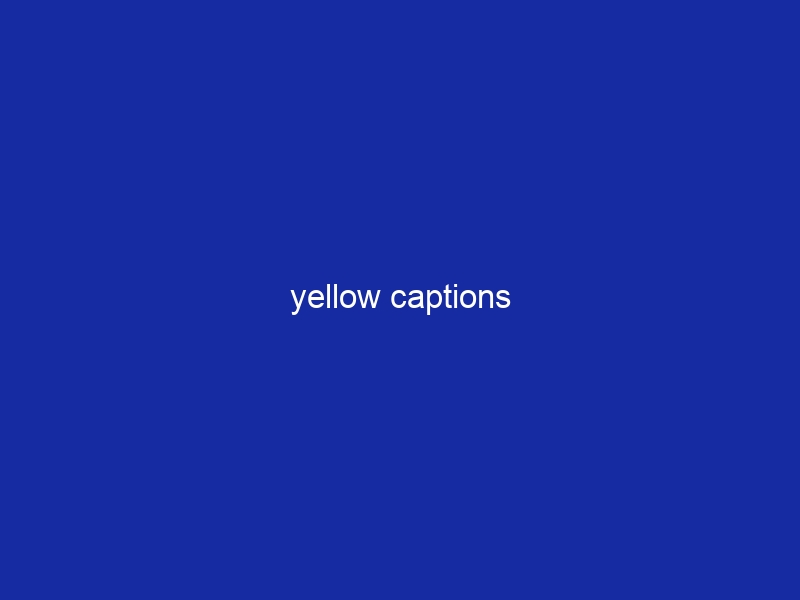The Impact of Yellow Captions on Accessibility and Inclusion
Yellow captions have become an important tool in promoting accessibility and inclusion for individuals with visual impairments. The use of yellow captions in various forms of media has greatly enhanced the ability of these individuals to access and understand content, thereby reducing barriers to information and promoting a more inclusive society.
Enhanced Visibility
One of the key benefits of using yellow captions is the enhanced visibility that they provide for individuals with visual impairments. The high contrast between the yellow text and the background makes it easier for these individuals to read and understand the content. This has a significant impact on their ability to engage with various forms of media, including television shows, movies, and online videos.
Improved Comprehension
Yellow captions have also been shown to improve comprehension for individuals with visual impairments. The use of yellow text makes it easier for these individuals to distinguish the captions from the rest of the content, allowing them to focus on the dialogue or narration without getting distracted. This improved comprehension enhances their overall media experience and encourages greater participation in various forms of media.
Facilitated Learning
Another important impact of yellow captions is their role in facilitating learning for individuals with visual impairments. By providing clear and legible captions in a high contrast color, yellow captions make it easier for these individuals to follow along with educational videos and other forms of instructional media. This not only promotes access to educational content but also helps to level the playing field for individuals with visual impairments in academic and professional settings.
Promotion of Inclusion
Yellow captions serve as a powerful tool in promoting inclusion for individuals with visual impairments. The use of yellow text ensures that these individuals are not left out of the media experience and are able to fully participate in conversations and discussions about various forms of media. This promotes a more inclusive society and helps to break down barriers between individuals with and without visual impairments.
Conclusion
In conclusion, the impact of yellow captions on accessibility and inclusion cannot be understated. The enhanced visibility, improved comprehension, facilitated learning, and promotion of inclusion make yellow captions an essential tool for individuals with visual impairments. It is crucial that content creators and media producers continue to prioritize the use of yellow captions to ensure that individuals with visual impairments are not excluded from the media experience.
FAQs
What are some examples of media that use yellow captions?
Some examples of media that use yellow captions include television shows, movies, online videos, and educational content.
How do yellow captions enhance accessibility for individuals with visual impairments?
Yellow captions enhance accessibility by providing high contrast text that is easier for individuals with visual impairments to read and understand.
What impact do yellow captions have on inclusion?
Yellow captions promote inclusion by ensuring that individuals with visual impairments are not left out of the media experience and are able to fully participate in conversations and discussions about various forms of media.
yellow captions
Yellow captions have a significant impact on accessibility and inclusion for people with visual impairments and other disabilities. The use of yellow captions makes it easier for individuals with low vision to read and understand the content of videos and other audio-visual materials. This can enhance their overall viewing experience and improve their ability to access information that may have previously been inaccessible to them.
Furthermore, yellow captions can also benefit individuals with learning disabilities and cognitive impairments. The use of color in captions can help to differentiate between different elements of the text, making it easier for these individuals to follow along and comprehend the information being presented. This can be especially beneficial in educational settings, where visual aids are often used to support learning.
In addition, yellow captions can promote inclusion by making audio-visual content more accessible to people who are deaf or hard of hearing. By using color to distinguish the captions from the rest of the visual content, individuals who rely on captions to understand spoken dialogue can more easily follow along with the video. This can help to ensure that people with hearing disabilities are not excluded from accessing and enjoying the same content as those without disabilities.
Moreover, the use of yellow captions can also benefit individuals who speak English as a second language. By providing color-coded captions, it can be easier for non-native English speakers to understand and follow along with the dialogue in videos and other audio-visual materials. This can help to bridge language barriers and promote inclusion for people from diverse linguistic backgrounds.
Furthermore, the use of yellow captions can also have a positive impact on individuals with attention difficulties or sensory processing issues. By providing an additional visual cue in a different color, it can make it easier for individuals with these challenges to focus and comprehend the information being presented. This can help to ensure that everyone, regardless of their abilities or disabilities, is able to access and understand the content being presented.
In conclusion, the impact of yellow captions on accessibility and inclusion is significant. By making audio-visual content more accessible and comprehensible to individuals with visual impairments, learning disabilities, cognitive impairments, hearing disabilities, language barriers, and attention difficulties, yellow captions can help to ensure that everyone has equal access to information and entertainment. This can ultimately contribute to a more inclusive and diverse society where individuals of all abilities are able to participate and engage with multimedia content. yellow captions

